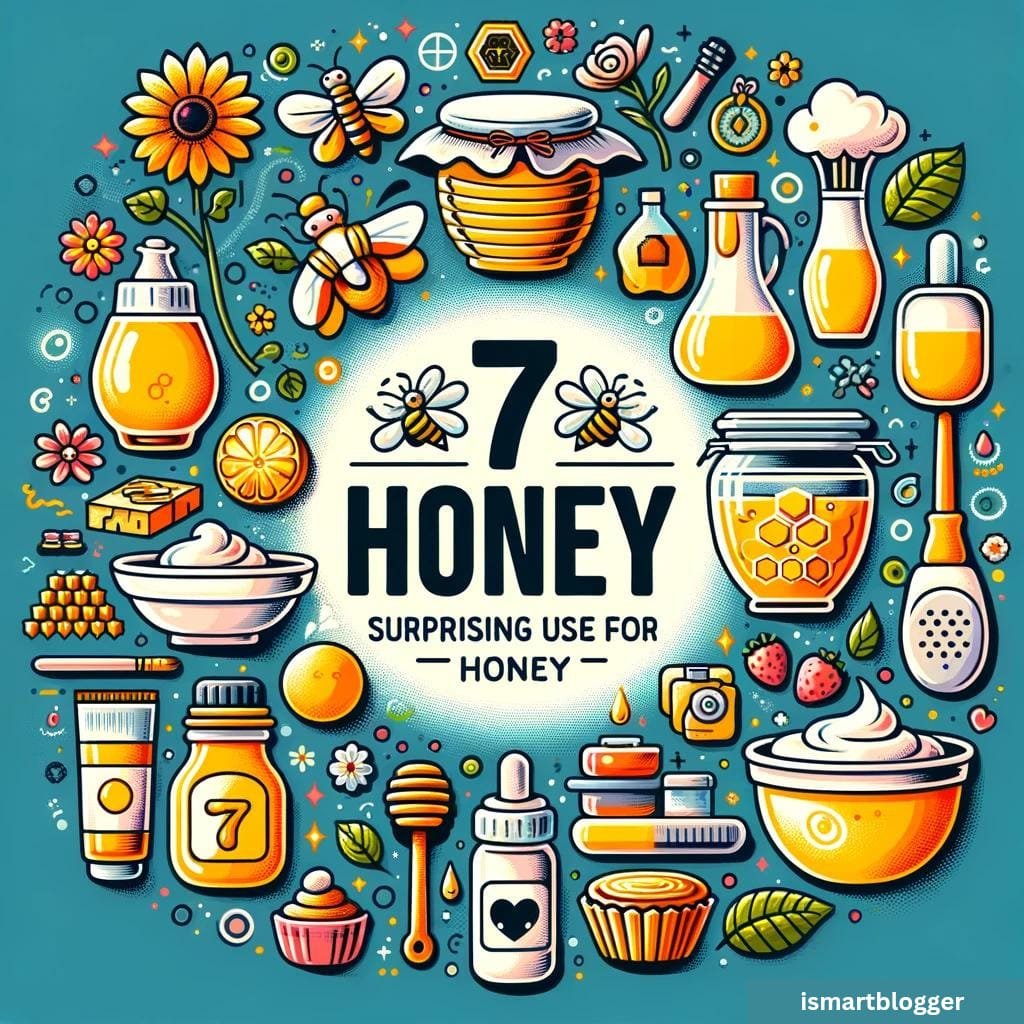Introduction
Honey, with its golden hues and delectable sweetness, has been a staple in human diets for centuries. This natural sweetener derived from the nectar of flowers has not only tantalized our taste buds but also captivated our imaginations with its numerous health benefits.
Besides being a delicious alternative to refined sugars, honey possesses remarkable antimicrobial, anti-inflammatory, and antioxidant properties that have made it an essential pantry item in households worldwide. Historically revered for its medicinal value, honey has been used in traditional medicine to treat various ailments and boost overall well-being.
Rich in vitamins, minerals, enzymes, and trace elements, this liquid gold not only satisfies our cravings but also provides a plethora of health-promoting qualities. From soothing sore throats to promoting digestive health and enhancing wound healing, honey is truly a versatile ingredient that offers more than meets the eye.
As fascinating as honey’s reputation as a natural sweetener and remedy may be, there are lesser-known uses of this remarkable substance that continue to surprise even the most ardent enthusiasts. In the sections to follow, we will delve into some of these unexpected applications where honey shines beyond its usual culinary role.
Prepare to be amazed as we explore the wonders of honey in skincare routines for radiant complexions or uncover its potential as an energy booster for athletes seeking natural fuel alternatives. Let us embark on this journey together as we uncover the hidden secrets behind one of nature’s most remarkable creations – honey!

Honey as a Skincare Wonder
When it comes to skincare, honey is not just a sweet treat for your taste buds. Its remarkable antibacterial and moisturizing properties make it a versatile and effective ingredient for improving the health and appearance of your skin. Honey’s antibacterial properties can help fight off acne-causing bacteria, while its moisturizing qualities can keep the skin hydrated and supple.
Explanation of honey’s antibacterial properties
Honey contains natural antimicrobial agents like hydrogen peroxide, which can inhibit the growth of bacteria on the skin. This makes it particularly beneficial for those struggling with acne-prone skin. The enzymes in honey also give it anti-inflammatory properties, reducing redness and swelling associated with breakouts.
Explanation of honey’s moisturizing properties
Honey is a natural humectant, meaning it attracts and retains moisture. When applied to the skin, honey forms a protective barrier that seals in moisture, preventing dryness and dehydration. Additionally, honey contains antioxidants that promote collagen production, keeping the skin firm and youthful-looking.
Surprising use: Honey face mask recipes for acne treatment, hydration, and exfoliation
One of the most exciting aspects of using honey in skincare is creating homemade face masks tailored to specific needs. Below are three surprising ways you can incorporate honey into your skincare routine:
Honey face mask for acne treatment:
Mix 1 tablespoon of raw honey with 1 teaspoon of cinnamon powder to create an acne-fighting mask. Apply this mixture to clean skin and leave it on for 15-20 minutes before rinsing off with warm water. The antibacterial properties of both ingredients work synergistically to combat acne-causing bacteria while soothing inflammation.
Honey face mask for hydration:
Combine 2 tablespoons of raw honey with half an avocado (mashed) and a teaspoon of olive oil to create a deeply hydrating mask. Apply this mixture to your face, avoiding the eye area, and leave it on for 20-30 minutes before rinsing off. Avocado provides nourishing fats and antioxidants, while honey moisturizes and revitalizes the skin.
Honey face mask for exfoliation:
Mix 1 tablespoon of raw honey with 1 tablespoon of finely ground oats and a teaspoon of lemon juice to create an exfoliating mask. Gently massage this mixture onto damp skin in circular motions, allowing the oats to slough off dead skin cells while the honey replenishes moisture.
Leave it on for about 10 minutes, then rinse thoroughly. By incorporating these surprising uses of honey into your skincare routine, you can harness its natural properties to achieve healthier, glowing skin.
Honey in the Kitchen Beyond Sweetening
Highlighting Honey’s Versatility in Cooking and Culinary Applications
Honey has long been appreciated as a natural sweetener, but its uses in the kitchen extend far beyond adding a touch of sweetness to your favorite recipes. This golden elixir offers a unique flavor profile that can enhance a wide range of dishes, both savory and sweet. Its versatility makes it an excellent ingredient to experiment with, allowing you to elevate your culinary creations to new heights.
The rich and complex taste of honey lends itself well to various culinary applications. When used sparingly, it can add depth and complexity to marinades, dressings, and sauces.
Its distinct floral or fruity notes can complement different ingredients, enhancing their flavors without overpowering them. For instance, a simple vinaigrette made with honey, Dijon mustard, olive oil, and lemon juice creates a harmonious balance that elevates any salad.
Surprising Use: Honey as a Natural Meat Tenderizer and Flavor Enhancer
One surprising use of honey in the kitchen is its ability to act as a natural meat tenderizer. The enzymes present in honey help break down proteins and collagen fibers in tougher cuts of meat, resulting in more tender and succulent dishes. To utilize this unique property of honey when cooking meat, you can create a simple marinade by combining honey with complementary ingredients like soy sauce or citrus juices.
Allow the meat to marinate for several hours or overnight before cooking for optimal results. Additionally, honey’s nuanced flavor profile adds complexity and enhances the taste of various meats.
It pairs exceptionally well with poultry such as chicken or duck when used as part of glazes or sauces. The natural sugars in honey caramelize during cooking processes like grilling or roasting, creating deliciously sticky coatings that lock in moisture while imparting a beautiful golden hue.
The result is a tender, juicy, and exquisitely flavored meat that will leave your taste buds delighted. Honey’s role in the kitchen extends far beyond its traditional use as a sweetener.
Its versatility allows it to be incorporated into a wide range of culinary applications, adding depth and complexity to dishes both savory and sweet. As a natural meat tenderizer, honey helps break down proteins, resulting in more succulent and tender meats.
Moreover, its unique flavor profile complements various ingredients and can be used to create delectable marinades, glazes, and sauces that elevate the overall dining experience. So next time you are experimenting in the kitchen, don’t forget to explore the surprising uses of honey beyond its sweetness.
Honey for Allergies Relief
The connection between local honey consumption and reduction in seasonal allergy symptoms
Seasonal allergies, such as hay fever, affect millions of people worldwide, leading to discomfort and a decreased quality of life during certain times of the year. While there are various medications available to alleviate symptoms, some individuals seek natural remedies to manage their allergies.
One such remedy gaining attention is the consumption of local honey. The theory behind this practice is that ingesting small amounts of local pollen present in the honey helps desensitize the body’s immune response to allergens over time.
The connection between consuming local honey and reducing seasonal allergy symptoms lies in a concept called immunotherapy or “allergy shots.” Allergy shots involve injecting small amounts of allergens into the body to build tolerance gradually. Similarly, consuming local raw honey acts as a natural form of immunotherapy.
Bees collect pollen from flowers in the vicinity where they reside, incorporating it into their honey production process. Studies supporting this theory are limited but promising.
The idea is that by regularly consuming small doses of local pollen found in honey, individuals may experience reduced allergic reactions when exposed to similar pollens through other means such as breathing them in outdoor environments. It’s important to note that this method may not work for everyone since allergic reactions can differ greatly among individuals depending on various factors like allergen sensitivities.
Surprising use: Consuming local raw honey to alleviate allergy symptoms
A surprising and lesser-known use for honey is its potential as a natural remedy for alleviating allergy symptoms. Local raw honey is often recommended due to its proximity and exposure to the specific types of plants causing seasonal allergies in your area. When consumed regularly, it is believed that exposure to these minute amounts of allergenic pollen can help build immunity or tolerance over time.
To effectively use local raw honey for allergy relief, it is recommended to start consuming it gradually, ideally a few months before the allergy season begins. Begin with a teaspoon of honey daily and gradually increase the amount over time.
It’s important to choose honey that is raw and unfiltered since heating or processing can diminish its potential benefits. Additionally, it’s crucial to consult with a healthcare professional before trying any natural remedy, especially if you have severe allergies or other underlying health conditions.
While local raw honey may not be a guaranteed cure for allergies, some individuals report a reduction in symptoms such as sneezing, runny nose, and itchy eyes after regular consumption. However, it’s worth noting that the research on this topic is limited and inconclusive.
Therefore, it’s essential to view local honey as an adjunct therapy alongside conventional medical treatments rather than a standalone solution for managing seasonal allergies. While the connection between consuming local honey and reducing seasonal allergy symptoms holds intriguing potential, further research is needed to establish concrete evidence supporting its efficacy.
If you decide to explore this natural remedy, remember that it should complement rather than replace medical advice or prescribed medications. Always consult with your healthcare provider before incorporating any new treatment into your allergy management regimen.
Honey as a Natural Cough Suppressant
Exploring the Science Behind Honey’s Effectiveness in Soothing Coughs
When it comes to relieving coughs, honey has been used for centuries as a natural remedy. Although it may seem counterintuitive to use a sweet substance to alleviate coughing, scientific research supports its effectiveness.
Honey possesses several properties that make it an excellent choice for soothing coughs. Firstly, its viscous texture creates a protective coating on the throat, providing instant relief from irritation and reducing the urge to cough.
Additionally, honey has antimicrobial properties that can help fight off bacterial infections in the respiratory tract, further aiding in alleviating cough symptoms. A study published in the journal “Pediatrics” found that children aged one to five years experienced significant relief from nighttime coughing when given two teaspoons of honey before bedtime.
The researchers concluded that honey was more effective than traditional over-the-counter remedies containing dextromethorphan or diphenhydramine. The natural sugars in honey also serve as an energy source for cells lining the throat, promoting faster healing and recovery from respiratory infections.
Surprising Use: Homemade Cough Syrup Recipes Using Honey, Lemon, and Other Natural Ingredients
In addition to using honey on its own as a natural cough suppressant, combining it with other ingredients can create homemade cough syrups that are both effective and delicious. One popular recipe involves mixing two tablespoons of lemon juice with two tablespoons of raw honey and a pinch of cayenne pepper. Lemon juice provides vitamin C to boost the immune system while also adding a refreshing taste to balance out the sweetness of honey.
Another homemade option is combining one tablespoon each of raw honey and apple cider vinegar with warm water or herbal tea. Apple cider vinegar helps thin mucus secretions while offering antiviral properties.
This concoction can be sipped throughout the day to provide relief from coughing and congestion. For those who prefer a soothing herbal blend, mixing honey with freshly brewed chamomile tea and a dash of cinnamon can create a calming cough syrup.
Chamomile has anti-inflammatory properties that can help reduce throat inflammation, while cinnamon adds a pleasant flavor while also possessing antimicrobial properties. These homemade remedies not only alleviate cough symptoms but also provide additional health benefits.
Honey’s effectiveness as a natural cough suppressant is supported by scientific research and centuries-old folk wisdom. Its soothing properties, combined with antimicrobial effects, make it an excellent choice for relieving irritation in the throat and reducing the urge to cough.
By combining honey with other natural ingredients like lemon juice, apple cider vinegar, or herbal teas, homemade cough syrups can be created that are not only effective but also enjoyable to consume. Before turning to over-the-counter medications, consider harnessing the power of honey as a safe and delicious remedy for alleviating bothersome coughs.
Honey for Wound Healing
In addition to its culinary and skincare uses, honey has long been recognized for its remarkable healing properties. The antimicrobial and anti-inflammatory properties of honey make it an excellent natural remedy for promoting wound healing.
Throughout history, honey has been applied to wounds to prevent infections and accelerate the healing process. Modern scientific research has further confirmed the effectiveness of honey in wound care.
The Antimicrobial Power of Honey
One of the key factors that contribute to honey’s efficacy in wound healing is its potent antimicrobial activity. Honey contains natural hydrogen peroxide, an antiseptic agent that helps kill bacteria and prevent infections. Moreover, certain types of honey, such as Manuka honey from New Zealand, possess additional antimicrobial components like methylglyoxal (MGO), which provides even stronger antibacterial effects.
Surprising use: Medical-grade Manuka Honey
While all types of raw honey can aid in wound healing to some extent, medical-grade Manuka honey stands out as a remarkable option due to its unique properties. Produced by bees that collect nectar from the Manuka bush (Leptospermum scoparium), this type of honey exhibits exceptional antibacterial activity even against antibiotic-resistant strains.
Medical-grade Manuka honey is widely used in clinical settings for treating burns, ulcers, and surgical wounds with incredible success rates. Its ability to stimulate tissue regeneration and reduce inflammation makes it a valuable tool in modern wound care practices.
Furthermore, medical-grade Manuka honey creates a moist environment on the wound surface, which aids in faster healing by preventing scab formation and promoting new cell growth. By harnessing the power of nature’s golden elixir—honey—wound care professionals have found an effective alternative or complement to conventional treatments.
Medical-grade Manuka honey, in particular, offers exceptional wound-healing properties that go beyond conventional expectations. Its antimicrobial activity and ability to promote tissue regeneration make it a valuable addition to the arsenal of wound care products, helping patients recover faster and with reduced complications.
Honey as an Energy Booster
In addition to being a delectable natural sweetener, honey possesses unique properties that make it an excellent source of sustained energy. Unlike refined sugar or artificial sweeteners, honey contains a mix of glucose and fructose, which are simple sugars that the body can quickly convert into energy. However, what sets honey apart is its slightly higher ratio of fructose to glucose compared to other sugars.
This composition allows for a slower release of glucose into the bloodstream, providing a steady supply of energy over a more extended period. For athletes and fitness enthusiasts seeking a natural and reliable source of energy, incorporating honey into their pre-workout routine can yield significant benefits.
Homemade energy gels using honey have gained popularity among endurance athletes due to their simplicity and effectiveness. By combining honey with other natural ingredients like lemon juice or sea salt, these DIY energy gels offer the perfect blend of carbohydrates for sustained fuel during intense physical activities.
Surprising use: Pre-workout or endurance athlete fuel with homemade energy gels using honey
One surprising use that has garnered attention from the athletic community is using homemade energy gels formulated with honey as a pre-workout or mid-race fuel source. These gels provide easily digestible carbohydrates that can be rapidly absorbed by the body to sustain performance without causing spikes in blood sugar levels.
To create your homemade energy gel using honey, start by combining 1-2 tablespoons of raw honey with some freshly squeezed lemon juice. The lemon juice adds a burst of flavor while providing electrolytes like potassium and magnesium to support hydration levels during strenuous exercise.
The high glycemic index (GI) value of honey ensures quick availability of energy without causing crashes later on. With this homemade concoction conveniently stored in small squeeze bottles or portable containers, athletes can simply consume a few sips or squirts as needed during their workout or race, avoiding the need for commercial energy gels packed with preservatives and artificial ingredients.
Conclusion
Recap of the Surprising Uses Discussed Throughout the Outline
Throughout this article, we have delved into the lesser-known and surprising uses of honey beyond its role as a natural sweetener. We explored how honey can work wonders for your skin, serving as a nourishing face mask that tackles acne, hydrates dry skin, and gently exfoliates to reveal a radiant complexion. Additionally, we discovered how honey can elevate your culinary creations by acting as a natural meat tenderizer and flavor enhancer in savory dishes.
Furthermore, we explored honey’s potential as an ally against allergy symptoms. By consuming local raw honey regularly, one may experience relief from seasonal allergies through its immunotherapy-like effects.
Alongside its allergy-fighting properties, we unveiled how honey acts as an effective cough suppressant when combined with lemon to soothe those irritating throat tickles. Additionally, we dived into the remarkable wound-healing abilities of medical-grade Manuka honey.
Its antimicrobial properties make it invaluable for treating burns, ulcers, and surgical wounds effectively. We discovered that honey can be an energy booster before workouts or during endurance activities due to its unique composition providing sustained energy levels.
Encouragement to Explore Beyond Conventional Uses of This Versatile Ingredient
As you come to the end of this article on the surprising uses for honey, I encourage you to take a step further in exploring the vast potential this versatile ingredient holds. Honey is not just confined to sweetening our tea or baking delightful treats; it has remarkable benefits for our skin health, kitchen adventures, allergy relief efforts, cough suppression needs, wound healing endeavors and even boosting our energy levels naturally. So go ahead and embrace the unexplored territory of using honey in unconventional ways.
Incorporate it into your skincare routine with homemade face masks or experiment with unique marinades and glazes in your culinary creations. Explore the local honey offerings in your area to alleviate allergy symptoms or whip up a homemade cough syrup to calm those pesky coughs.
Remember that honey has the power to heal wounds effectively and provide a natural energy boost for your active lifestyle. Honey is not just an everyday sweetener. It is a multi-dimensional elixir of surprises that can enhance various aspects of our lives. So, let us embark on this journey of discovering the hidden potential within a jar of golden goodness and unlocking the extraordinary benefits that nature has bestowed upon us.





